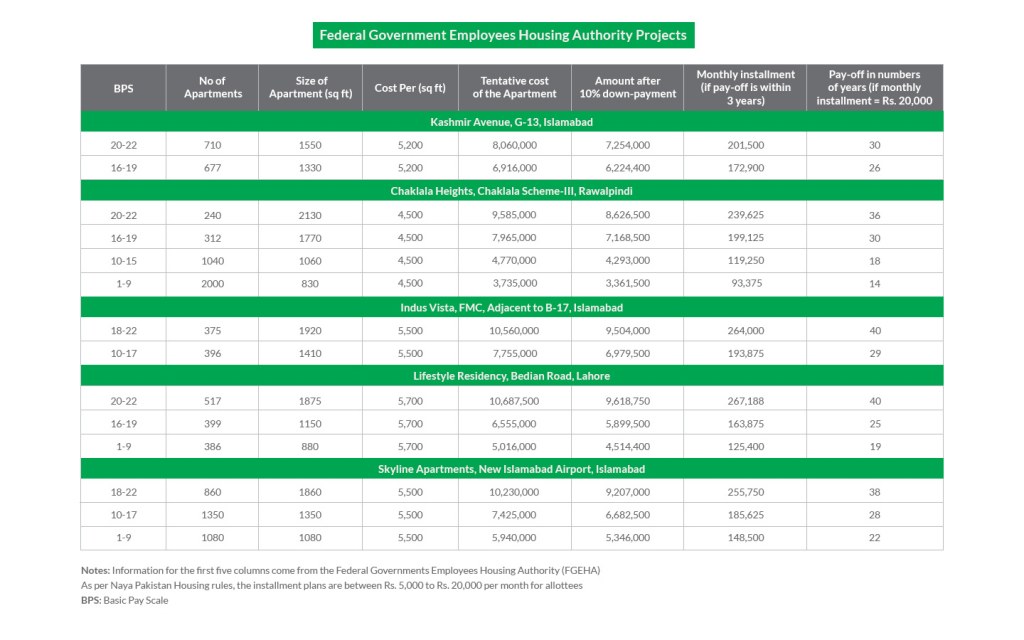Home » Construction » Naya Pakistan Housing: The Curious Case of Government Employees Housing
As previously discussed in our series of articles, the main challenge faced by the government in implementing its Naya Pakistan Housing Plan is ensuring house affordability. In theory, it is meant to increase the supply of housing in the market for low to middle-income households where the demand-supply gap has been widening. This meant that said housing would be affordable for the above-mentioned income groups and though the challenges of affordability are well-established, the asking price for these houses were supposed to be at least lower than market rates. This may not be the case.
The Federal Government Employees Housing Authority (FGEHA) announced that it will be constructing 12,000 apartments in various cities under the NPHP. The apartment projects include: a) Kashmir Avenue Apartments (FGEHA) Mauve Area, G-13, Islamabad b) Chaklala Height (FGEHA) Chaklala Scheme-III Rawalpindi, c) Indus Vista (FGEHA) B-17 Islamabad, d) Skyline Apartments (FGEHA) Islamabad International Airport Islamabad, and e) Lifestyle Residency (FGEHA) Bedian Road, Lahore.
Under these five projects, a total of 10,342 apartments have been allocated and true to the spirit of NPHP, the lowest income employees with the Basic Pay Scale (BPS) range of 1-9 have the highest number of allocation (34% of total) while 26 percent of allocations are for BPS range of 10-17.

The sizes of the apartments are also according to the income brackets of the federal employees which also makes sense, though price per sq. ft. is the same for employees buying any apartment size. However, the problematic aspect here are the final prices. Chaklala Heights in Rawalpindi, Lifestyle Residency in Lahore, and Skyline Apartments Islamabad are offering apartments for federal employees in the lowest BPS range i.e.: 1-9. These are employees that have starting monthly income between ~ Rs9,000 to Rs12,000, upto Rs23,000 after adding allowances. These employees cannot afford to buy apartments in the range of Rs 3.7 million to Rs5.9 million.
Assuming the project will be completed within three years—which is the minimum time the delivery of an apartment building typically takes—the monthly installment these employees will have to pay is between Rs93,000 (~4 times the monthly salary of Rs23,000) to Rs148,000 (~6 times the monthly salary of Rs23,000). These multiples make a serious case of housing unaffordability. The same argument can be made for officers in the BPS ranges of 9 and above. Can they pay these installment amounts?
An important point here is to remember that under the NPHP, allottees can opt for one of the three installment plans which are: in the lowest category, applicants will pay a monthly Rs5,000 to Rs10,000 after a 10 percent initial down-payment; Rs10,001 to Rs15,000 in the middle category and in the highest category, applicants will pay between Rs15,001 to Rs20,000. If the highest installment plan has an upper limit of Rs20,000 and if the FGEHA projects are indeed certifiably under NPHP, how many years will it take applicants to pay off the cost of the apartment? A simple calculation suggests, between 14 to 40 years but obviously, this is not possible.
The other option is going for a mortgage but the most affordable mortgage available in the market is the fixed rate mortgage (12% interest along 20 year tenor) provided by the House Building Finance Company (HBFC)’s Ghar Pakistan Schemes. However, this scheme is only available to applicants buying a house that costs up to Rs4.5 million. Only 2000 apartments in the list above would qualify for this mortgage. The monthly installment individuals will be giving under the mortgage is ~Rs37,000—1.6x the monthly salary of a Grade 9 employee.
Will there be some form of subsidy to pay the differential amount by the government? Will the government be able to tackle this fiscal burden? And the eventual question, Will housing be available to those in need through NPHP? These questions will help the government plan its affordable housing program much more efficiently.



